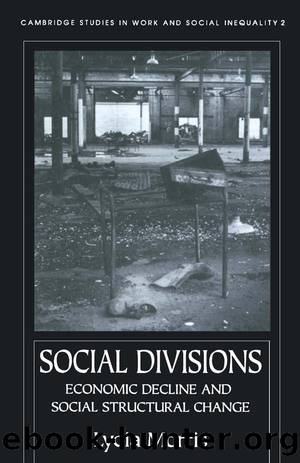Social Divisions by Lydia Morris

Author:Lydia Morris [Morris, Lydia]
Language: eng
Format: epub
Tags: Social Science, Sociology, General
ISBN: 9781317973126
Google: YNC3AwAAQBAJ
Publisher: Routledge
Published: 2014-06-03T04:59:32+00:00
Chapter Five
Women's employment histories1
We have referred so far to a number of aspects of the underclass debate, but there are two specific and related issues that arise in the context of household concentrations of unemployment. One concerns the definition of the underclass, the other concerns the relationship between husbands' and wives' employment histories; the two are linked. Some treatments of the underclass take a household perspective, so Smith (1992: 4), for example, defines the term as: âThose who fall outside [the] class schema because they belong to family units having no stable relationship at all with the âmode of productionâ â with legitimate gainful employment.â
This definition, although having a certain intuitive appeal, would in practice define a long-term unemployed man with an unemployed wife as a member of the underclass, but exempt him if his wife was in paid work. Yet much discussion about the underclass is focused on individual motivation and the will to work. More of a problem is the implicit inclusion in this definition of the retired and the disabled.
The will to work is an issue at the heart of the underclass debate, and as we saw in the previous chapter, Murray (1990:18) argues that: âAn unknown but probably considerable number of people ⦠manage to qualify for benefit even if in reality very few job opportunities would tempt them to work.â Much of the related debate has concerned single mothers, but the employment status of the wives of unemployed men has also been a focus of interest in this context. For most commentators, the evidence seems to point to the absence of a work incentive in the face of low-income disregards for benefit claimants (see Ch. 2).
A strong association between the labour force statuses of husband and wife couples has been identified in a series of empirical studies (e.g. Pahl 1984; Harris 1987; Joshi 1984; Moylan 1984), and was remarked upon with regard to the Hartlepool data given in Chapter 2.2 There is a tendency in social policy debate to explain this association by the very low ceiling on permitted earnings for benefit claimants and their spouses. The associated argument that husbands' unemployment causes wives to withdraw from paid employment, and that benefit regulations present an obstacle to the availability of female labour and a disincentive to female labour-supply flexibility, is referred to throughout this chapter as the âsocial security modelâ. Much of the research interest in the coincidence of spouses' employment status has focused on the question: What do the wives of unemployed men do? (e.g. Dilnott & Kell 1989; Cooke 1987). A general review of this material by Cooke concludes that, âother things being equalâ, women married to unemployed men are less likely to be working than their ostensible peers who are married to employed men. This suggests two possibilities: one is to deduce a direct influence within the household on women's employment decisions, the other is to question how far âother thingsâ truly are equal.
This chapter considers the relationship between economic structure and
Download
This site does not store any files on its server. We only index and link to content provided by other sites. Please contact the content providers to delete copyright contents if any and email us, we'll remove relevant links or contents immediately.
Adding Value to Policy Analysis and Advice by Claudia Scott; Karen Baehler(460)
Sociological Perspectives of Health and Illness by Constantinos N. Phellas(449)
Race and American Political Development by unknow(447)
American Government and Politics Today by Steffen W. Schmidt Mack C. Shelley Barbara A. Bardes(435)
Human and Global Security : An Exploration of Terms by Peter Stoett(429)
Control Of Oil - Hardback by Kayal(411)
Entrepreneurship Education and Training: The Issue of Effectiveness by Colette Henry Frances Hill Claire Leitch(378)
Advances in Child Development and Behavior, Volume 37 by Patricia J. Bauer(368)
Materializing the Middle Passage by Jane Webster;(366)
The Catholic Church and European State Formation, AD 1000-1500 by Jørgen Møller(359)
The World According to China by Elizabeth C. Economy(347)
Left Is Not Woke by Susan Neiman(330)
Turkey's Relations with the West and the Turkic Republics: The Rise and Fall of the Turkish Model by Idris Bal(318)
Theories of Counseling and Psychotherapy: A Case Approach by Nancy L. Murdock(318)
Cross-Cultural Child Development for Social Workers by Lena Robinson(314)
Japan's Ainu Minority in Tokyo by Mark K. Watson(301)
Laboratory Life by Bruno Latour(296)
Beyond Service: State Workers, Public Policy, and the Prospects for Democratic Administration by Greg McElligott(287)
The Oxford Handbook of Museum Archaeology by Stevenson Alice;(278)
